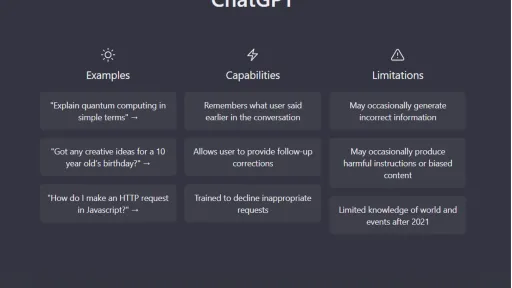Open your LinkedIn and you can't miss it. Everywhere there are posts about ChatGPT and how everyone is using it. But what exactly is it and how can it work to your advantage? By asking the right questions, it can save you a lot of time in drafting your content calendar for next month, determining your strategy for the coming period, and it can provide new inspiration for upcoming campaigns.
We show you 10 ways to use ChatGPT for your social media channels.
What is ChatGPT?
ChatGPT is an advanced language model developed by OpenAI. It can generate and understand text. This allows it to answer the questions you ask, engage in conversation, and generate text that appears to be written by a person. ChatGPT can also understand context and intent, providing even more relevant answers. It is a powerful tool for developers working on language-based applications and can be used for a wide range of purposes, from chatbots to text generation for Artificial Intelligence (AI).
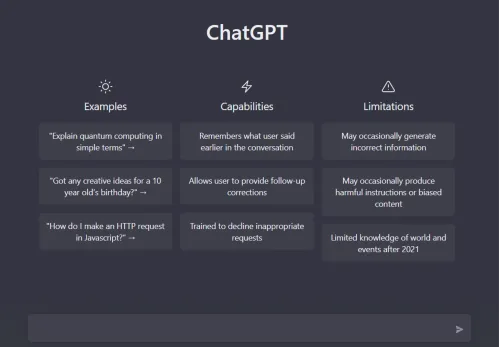
Using as a chatbot
ChatGPT can be used to generate the conversations of a chatbot and help the user with their question or request. A chatbot based on ChatGPT can be integrated into social media platforms like Facebook, Twitter, Instagram, and others. The user can send a message to the chatbot, which will then provide an answer written by ChatGPT. As a company, you can use this for customer service, but also for e-commerce to advise a person on which product they should buy or to process an order.
The advantage of ChatGPT is that it can analyze the sentiment of the messages being sent. This way, the chatbot provides a more “human” answer than other chatbots. The system analyzes whether the messages are positive or negative and can adjust texts and strategies based on existing data. It recognizes frequently asked questions and can therefore answer the question correctly earlier in the conversation.
Writing copy for posts and ads
One of the most obvious applications of ChatGPT on social media is automatically generating text for social media posts. Many companies and brands use social media to promote their products or services, but it can be difficult to regularly produce relevant and interesting copies. ChatGPT can help by automatically generating text suitable for social media posts, such as tweets, Facebook posts, Instagram captions, or LinkedIn updates.
In addition to writing standard texts for social media, ChatGPT can also come up with interactive content. To tailor this well to your followers, data is needed, such as interests, demographic data, and actions taken on social media channels. By recognizing patterns of users, the model can create content tailored to your followers, which is expected to increase the interaction rate. For interactive content, you can think of (personalized):
- Quizzes
- Videos
- Chatbots
Because this is personalized and tailored to your target audience, the brand experience will also improve.
You can ask ChatGPT to write previous text variants. This way, you can immediately create different variants of your ads to A/B test. Other content the model can supplement includes example relevant hashtags on a particular topic. This way, you make your entire post complete and more discoverable.
We have already conducted the first tests with texts from ChatGPT and our own. The result? The texts written by us result in a click-through rate of 3.4%, texts from ChatGPT have a CTR of 3.16%. A minimal difference, so it's definitely worth testing what works best for you or using ChatGPT for inspiration.
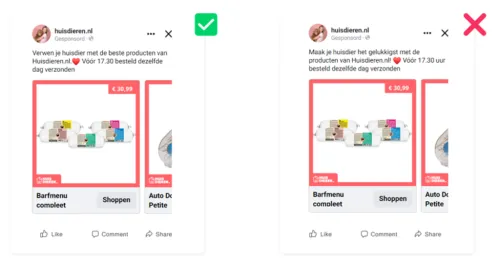
Influencer marketing
Influencer marketing can help make your brand bigger and more well-known among a specific target audience. We see more and more emerging influencers on different platforms. Sometimes it's impossible to properly analyze which influencer really fits your brand and with which influencers you are likely to achieve the best results. But ChatGPT can help with that. The system looks for patterns and can predict which users have the most influence on your target audience. This can be based on demographic data, interests, and behavior on social media. With this data, it can create content for both the influencer and the brand. By collecting all the data, messages can be created that generate more interaction, allowing your brand to grow.
Additionally, ChatGPT can be used to analyze data from influencer campaigns to determine how effective these campaigns have been. This can be done by looking at indicators such as the number of views, likes, comments, and conversions. This allows you to optimize your campaigns and organic content and respond to the preferences of the target audience.
Developing artificial influencers
With influencer marketing, the tool mainly focuses on analyzing statistics to make the right match between a company and an influencer. But we challenged the tool to go a step further, namely creating an artificial influencer. How does this work? The model can be trained on a dataset with text from real influencers, allowing it to generate text that resembles the text a real influencer might post. This way, a virtual person can be created with their own personality and style, who is active on social media. By further developing this, an artificial influencer can be used to promote products and/or services and build a community.
Of course, we wanted to test this! We asked ChatGPT to create an artificial influencer for a website about and for pets. The influencer was described as follows:
Let's create an artificial influencer for a website about pets called “Pet Paradise”. Our virtual influencer will be an enthusiastic pet owner who loves to share her experiences and tips with other pet owners.
Let's name the virtual influencer “Max”. Max is a young dog lover who has just adopted a puppy and is now enthusiastically participating in the training and raising of her new dog. Max regularly shares photos and videos of her puppy on social media, as well as stories about the challenges and triumphs she encounters while raising her dog. She also shares tips and tricks for dog training and health and invites other pet owners to share their own stories and questions.
With the help of ChatGPT, we can train Max to generate text that fits her virtual personality. This can include social media posts, blog posts on the Pet Paradise website, or even answering user questions in a chatbot. By creating the virtual influencer Max, Pet Paradise can create a new way of content that connects with their target audience while building a bond with pet owners.
Max can be used to review products related to pets, such as food, toys, and health products. This can be an interesting way to recommend products to the target audience while building a bond with users. Max can also be used to organize events such as meet-ups for pet owners or online training sessions where dog lovers can train their dogs.
And of course, we needed an image or video. ChatGPT cannot create this, but it can provide a description that can be used to generate it via another tool, such as DALL-E 2 or Canva. We tested this as well:
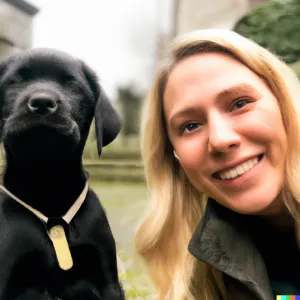
Our conclusion? These systems still struggle with certain requests when creating an image, such as details like eyes. Additionally, it remains a challenge to consistently bring back the same person and dog when creating multiple images and videos.
Storytelling
Another application is automatically generating stories. Many people love stories, whether in the form of books, movies, or social media posts. ChatGPT can be used to automatically create stories that are shared on social media. This can be a new way to create content that appeals to users while also contributing to strengthening the bond with the target audience.
To continue with our artificial influencer Max, we asked ChatGPT to write a story about her and her Labrador. This time in more detail and what keeps her busy.
A story that can be used for storytelling via Instagram for artificial influencer Max is the following:
Max has just adopted a new puppy named Rocky. Rocky is a Labrador Retriever and is full of energy and enthusiasm. Max is very happy with her new housemate and decides to share the story of Rocky's first months with her followers via Instagram.
The story begins with a series of photos of the first meeting between Max and Rocky, in which Max talks about how she adopted Rocky and how happy she is with her new housemate. The following posts are about the first days at home with Rocky, in which Max describes the challenges she encounters, such as teaching the house rules and getting used to her new environment.
As the weeks go by, Max continues to share Rocky's stories, in which she talks about how she teaches Rocky to walk on a leash, how she teaches her tricks, how she socializes her with other dogs, and how she prepares her for her first visit to the vet. She also shares photos and videos of Rocky playing with her Pet Paradise toys and enjoying her meals from Pet Paradise.
The story continues with the first big outings with Rocky, such as a weekend trip to the campsite. Max shares photos and videos of Rocky enjoying the outdoors and talks about how she prepared Rocky for this trip.
The story ends with a post in which Max says that Rocky has now become an adult dog and how grateful she is for the time they have had together. She invites her followers to share their own stories about their pets and to follow Rocky for more tips and stories.
This story gives Max the opportunity to build a bond with her followers by showing them how she raises Rocky and how she enriches her life. It also gives Pet Paradise the opportunity to integrate their products into the story, such as toys and food, and reach their target audience.
Determining target audiences
ChatGPT can be used to analyze data from social media users and identify patterns that may indicate specific target audiences. This makes it extra interesting to create content and campaigns from the tool. By recognizing patterns, ChatGPT knows what your target audience responds to and will react to. After analyzing the target audience, it can automatically generate content that matches the interests. This way, you always know you're posting the right content.
Are you just starting with your business and don't have social media channels yet? Then you can ask which target audience matches your company's keywords. This gives you a bit more guidance to focus your targeting within the various social media platforms. This can look like this
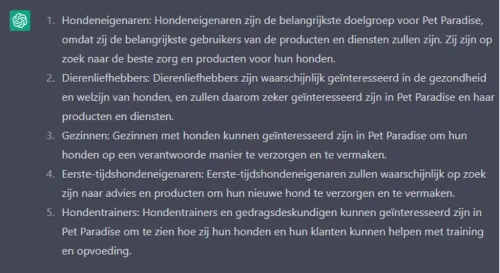
Branding campaign concepts
ChatGPT can mean and come up with a lot for social media. From coming up with stories to writing content. The tool can also think along in coming up with a branding campaign. By providing some details, it gets to work creating an action around the topic you have indicated.
We gave the task to come up with a campaign for social media where the virtual influencer Max was used to promote the company Pet Paradise:
A social media campaign that Pet Paradise can use to better promote their webshop to the target audience is the “Rocky's Wishlist Challenge”. Here, Pet Paradise would select a number of their products suitable for puppies and include them in a “wishlist” for Rocky. Max would then try out some of these products and share them with her followers via Instagram.
The campaign would start with a post in which Max invites her followers to do the “Rocky's Wishlist Challenge”. In the post, she would show the products on Rocky's wishlist and share a link to the Pet Paradise webshop.
Then, over the course of a few weeks, Max would post a number of posts in which she tests the products from the wishlist and shares her experiences and findings with her followers. She would share photos and videos of Rocky playing with the toys, for example, or photos of Rocky eating the food.
To give the campaign extra interaction, Pet Paradise would organize a contest where Max's followers have a chance to win the same products as on Rocky's wishlist. Here, Pet Paradise would ask followers to share a photo of their own pet with the hashtag #RockysWishlistChallenge and choose a winner who receives the package with products.
Through this campaign, Pet Paradise would better promote their webshop to Max's target audience, who are interested in pet products, while building a bond with their followers by inviting them to participate in the challenge.
Not very innovative, but it can certainly provide inspiration to create a similar campaign.
Creating a content calendar
Working with a social media content calendar can help you better organize and plan your content. Sometimes you just get stuck because you're either posting the same thing over and over, or you run out of inspiration. In that case, ChatGPT can help! In addition to analyzing your content and coming up with texts for your posts, it can also create a content calendar for you. The content calendar can be adjusted based on historical data. ChatGPT analyzes which posts have performed well and creates new texts, advice for images, and your hashtags based on this. This way, you ensure that your content performs even better than it already did.
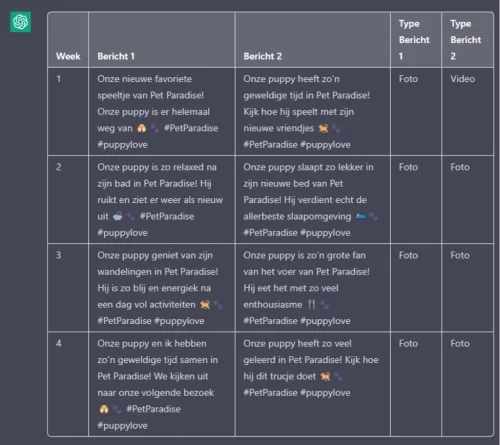
Social media monitoring
Social Media Monitoring is the continuous process where companies or organizations track and analyze online conversations about their brand or industry. The goal is to gain insight into your brand's reputation. One of the main ways ChatGPT can help you with social media monitoring is by analyzing large amounts of text data from social media platforms like Twitter, Facebook, Instagram, and others. This can be done by training the model on this data, so it can detect specific topics or even specific emotions.
Once trained, ChatGPT can be used to automatically generate reports that provide insight into how your brand is perceived by (potential) customers. This can be done, for example, by analyzing user sentiments towards your brand or by identifying specific topics that are often discussed in connection with your brand.
ChatGPT can also be used to automate social media monitoring by setting specific search terms or topics for the model to follow. This allows the model to continuously analyze large amounts of text data, keeping you informed of the latest developments and trends.
Additionally, ChatGPT can be used to collect data from specific groups, such as customers or competitors. This can be done by analyzing specific hashtags, search terms, or even specific accounts. This allows the model to collect specific information about the target audience or competitors, which can then be used to improve the social media strategy.
Predictive analytics
By collecting all the data from different social media channels, ChatGPT can make predictions about various statistics. ChatGPT can discover patterns and trends that may be relevant to adjust your social media strategy.
- Predicting trending topics: ChatGPT can be used to predict which topics will be popular on social media in the future.
- Predicting consumer behavior: ChatGPT can be used to predict how consumers will respond to specific social media campaigns or posts. This can be done by analyzing user sentiments towards the brand and identifying specific emotions that often occur in combination with the brand or the posts being made.
- Predicting sales: ChatGPT can be used to predict how many products or services will be sold based on social media analysis. This can be done by identifying specific topics that are often discussed in connection with the product or service and analyzing text data.
- Predicting the impact of a crisis: ChatGPT can be used to predict how a crisis will unfold on social media.
- Predicting the reputation of a brand: ChatGPT can be used to predict how a brand's reputation will develop on social media.
To make the above predictions, ChatGPT needs text data to analyze. From there, certain trends can be identified, and predictions are made.
Writing pixel events
ChatGPT can create a lot regarding content, analyze data, and adjust strategies. But it doesn't stop there. It can also help with writing more technical implementations such as pixel events, including parameters. It explains where to place it, and you can directly copy the code.
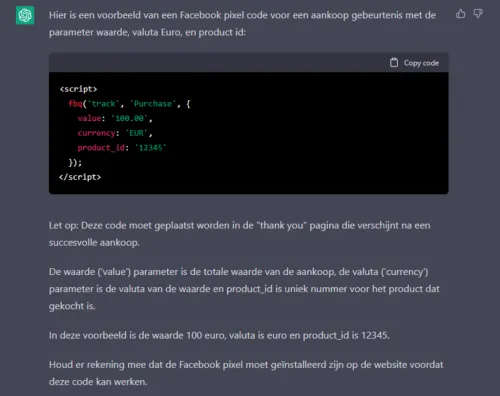
Conclusion
Will a tool like ChatGPT ever replace us as social media marketers? We don't think so. You can see it more as a tool to help come up with campaigns, write texts, or assist with more technical matters. It can analyze your campaigns and content and provide relevant input to further optimize your strategy. Of course, there are many more ways ChatGPT can be used and will be used in the future.
Do you want to know more about how to apply ChatGPT within social media? Or do you have another online question? Feel free to contact us.
